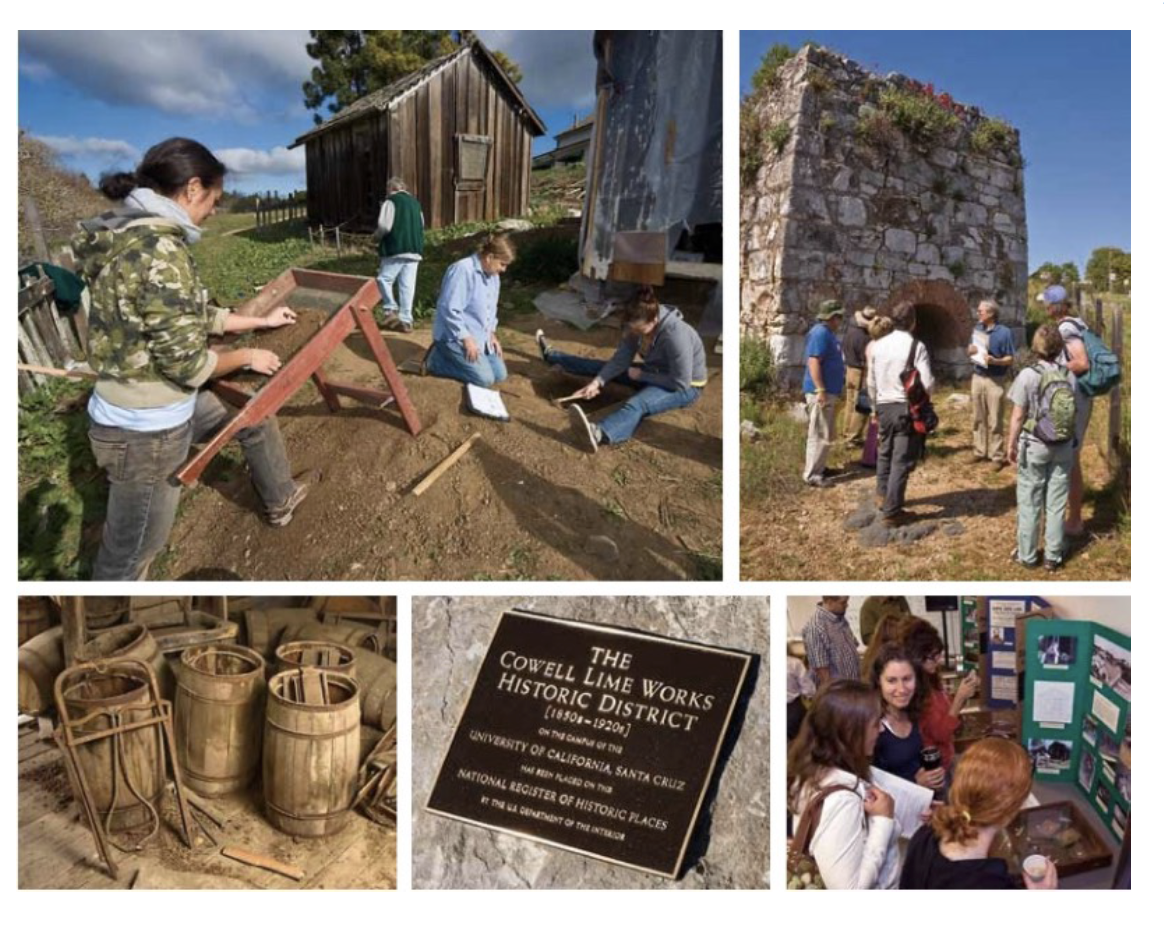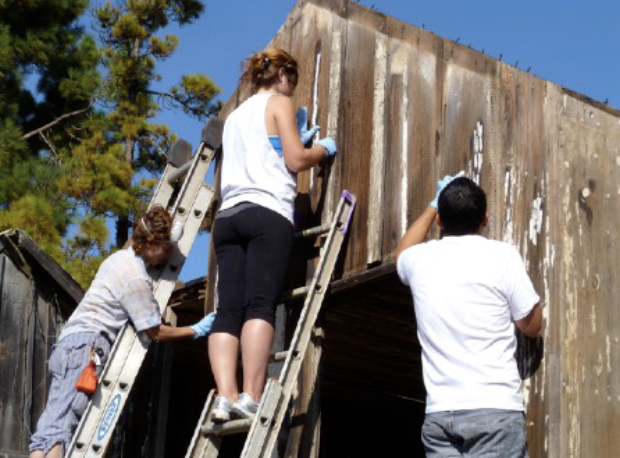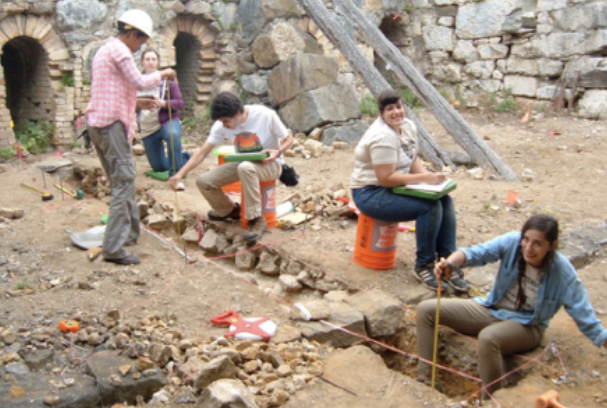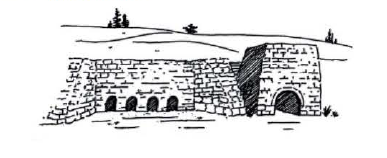About the District and our Friends Group
The Cowell Lime Works Historic District — Preserving History One Project at a Time
 Historical Context:
Historical Context:
In the late 19th and early 20th centuries, Henry Cowell and his family ran a thriving industrial operation on what is now the UC Santa Cruz campus. Limerock was quarried on the site and heated in kilns to convert it to lime— a key component in mortar, plaster and many essential industrial processes. The lime kilns, Cooperage (where barrels were assembled), Cook House, barns, and other surviving support structures represent the most complete nineteenth-century lime production complex remaining in California, and perhaps in the Western United States.
District Dedication:
In fall 2009, the Friends of the Cowell Lime Works Historic District, UC Santa Cruz Chancellor George Blumenthal, and local, state, and federal elected officials dedicated a brass plaque commemorating placement of the District on the National Register of Historic Places. The plaque is located near the Cook House. UCSC is the only UC campus to possess a nationally recognized Historic District.
Cooperage:
Built in 1869, the building design is similar to a covered bridge. Thanks to the support of the S. H. Cowell Foundation, in 2009 the structure was stabilized, preventing its collapse and providing the University and Friends with the opportunity to seek funding to rehabilitate the building for campus use. Rehabilitation work began in 2024.
 Lime Workers’ Cabins:
Lime Workers’ Cabins:
Plans call for the restoration or reconstruction of the five workers’ cabins on the hill opposite the Cook House. Archaeological investigations by students have provided a glimpse into the daily domestic life of the workers. Tobacco cans, a Portuguese religious medal, a woman’s mother-of-pearl hair pin, cattle bones, seashells, and a large assemblage of clothing fasteners excavated from the site reveal much about the lives of those who worked for the Cowell operations. One of the cabins has been partly restored by students, volunteers, and donations from the Cabrillo Civic Club and Alameda Roofing.
Hay Barn:
According to barn experts, the style of construction suggests this building dates from prior to 1870. It is a timber-framed structure with beautifully-fitted mortise-and-tenon joints. It was rehabilitated in 2015 with a grant from the Helen and Will Webster Foundation and is now used by UCSC’s Center for Agroecology. It is also rented out as a venue for weddings and other events.
Quarry Amphitheater:
This site is located on the upper campus. Known historically as the Rincon Quarry, limerock from here was quarried in the early 1900s and hauled to Cowell’s lime kilns at Rincon beside Highway 9. UCSC converted it to an amphitheater in 1966 and refurbished it in 2017.
 Educational Programs:
Educational Programs:
The Friends hosted the first-ever “Conference on Lime and Lime Kilns in California History.” The two-day event was attended by participants from throughout the West. The Friends also hosted the first-ever Santa Cruz County History Fair, bringing together historical organizations from throughout the region with displays and activities. Several organizations have taken turns hosting subsequent fairs. The Friends occasionally host walking tours of the District and since 2008 has published the Lime Kiln Chronicles newsletter, which delves more deeply into the district’s history.
Cardiff Shed:
This was used as a woodshed and storage shed by residents of the nearby Ranch House. It was rescued from a state of near collapse and fully restored with the help of students, volunteers, Architect Dennis Diego, Redtree Properties, and Cen-Con Construction.
Interpretive Signs:
Interpretive signs have been installed throughout the Historic District and at the Quarry Amphitheater thanks to a generous donation from Redtree Properties.
Ranch House (Cardiff House):
This was the permanent residence of the Cowell family from 1865 to 1879, and intermittently thereafter. The building underwent a seismic retrofit in 2016. This included construction of a perimeter foundation (something it never had before).
 Why preserve these historic buildings:
Why preserve these historic buildings:
• Were it not for the lime industry, UCSC would not exist. The campus was purchased from the S. H. Cowell Foundation a few years after the death of the last Cowell family member, Samuel Henry Cowell.
• It is the most intact 19th-century lime manufactur-ing complex in California and played a vital role in the state’s development in the decades following the Gold Rush.
• The District helps tell the stories of the immigrants who worked here in the 1800s and early 1900s and their contributions to the California economy.
• The Historic District provides opportunities for hands-on experiences for UCSC students and visitors rather than just pictures in books or on the internet.
• As the gateway to the campus, the Historic District offers a unique opportunity for re-use of historic buildings while preserving their historical integrity and making the campus entrance more welcoming.
Help support our ongoing work:
While much has been accomplished, many projects still await funding:
• Constructing walkways to make the historic features more accessible.
• Completing restoration of the workers’ cabins.
• Repairing damage to the lime kilns.
• Restoring the trestle that was used to bring ore cars of limerock to the kilns.
• Rehabilitating the Blacksmith Shop.
• Repairing the historic entry gate.
• Repairing and preserving wagons and equipment.
• Expanding UCSC student involvement.
• Expanding public education programs, including tours for grade-school groups.
Donations to the Friends of the Cowell Lime Works Historic District are tax-deductible and go towards projects such as these.
To learn more, follow us on Facebook, visit our website, and join The Friends: limeworks.ucsc.edu
The Friends is an official UCSC friends group and receives its nonprofit status through the UCSC Foundation.

Revised 2024
